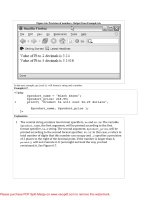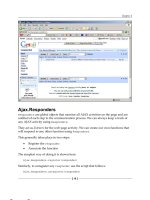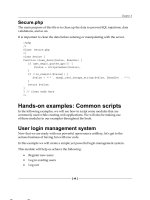Tài liệu PHP and MySQL by Example- P13 doc
Bạn đang xem bản rút gọn của tài liệu. Xem và tải ngay bản đầy đủ của tài liệu tại đây (1.22 MB, 50 trang )
Table 14.3. Most Common SQL Data Types
(%&%123"#
(#)*$+"&+',
maximum!size!is!specified!in!the!parentheses.
TINYTEXT
A!string!with!a!maximum!length!of!255!characters.
TEXT
A!variable8length!text!string!with!a!maximum!length!of!65,535!characters,!
used!for!storing!large!text!files,!documents,!text!areas,!etc.
BLOB
Binary!large!object.!A!binary!string!with!a!maximum!length!of!65,535!
characters,!used!for!storing!binary!files,!images,!sounds,!etc.
Date!and!Time
DATE
(yyyy-mm-dd)!year,!month,!day;!e.g.,!2006-10-30!(Note:!MySQL!also!allows!
you!to!store!0000-00-00!as!a!“dummy!date.”)
DATETIME
(yyyy-mm-dd hh:mm:ss)!date!and!time;!e.g.,!2006-10-30 22:59:59
TIMESTAMP
(yyyy-mm-dd hh:mm:ss)!date!and!time;!e.g.,!1970-01-01!(date!and!time!of!
last!transaction!on!a!row)
TIME
(hh:mm:ss)!time;!e.g.,!10:30:58
YEAR
(yyyy | yy)!year!in!four!or!two!digits;!e.g.,!1978!or!78
!
14.3.3. Creating a Table
Creating a table is a little more complicated than creating the database. The CREATE TABLE statement is used to
create a new table in the database. First you must name the new table and then specify all the fields that will be included
in the table as well as the data types and any other attributes. A data type can be an integer, a floating-point (real)
number such as 5.4, a string of characters, a date, a time, and so on. Not all databases will specify data types in the same
way. To see what data types and attributes are available for MySQL, see Table 14.3 or the MySQL documentation.
Designing your tables correctly is important and a subject that merits further research if you have not worked with
databases before. See for an excellent beginner’s
tutorial on database design. For now, here are some rules to keep in mind when designing the table:
451
Choose!the!right!data!type!for!your!fields;!for!example,!use!integer!types!for!primary!keys,!
use!float!and!double!types!for!large!numbers,!use!decimal!or!numeric!types!for!currency,!
use!the!correct!date!format!for!times!and!dates,!and!give!yourself!ample!field!width!for!
strings!containing!variable!numbers!of!characters,!such!as!names!and!addresses.!If!you!are!
saving!binary!data!such!as!images!and!sounds,!use!a!data!type!that!supports!such!large!
amounts!of!data!such!as!blob!and!text!types.!See!Table!14.3.
651
Give!columns!sensible!and!concise!names.!Make!them!unique!within!the!table.!Do!not!have!
duplicate!columns!in!the!same!table,!as!shown!below.!These!should!not!be!three!columns!
all!headed!with!phone.!
Please purchase PDF Split-Merge on www.verypdf.com to remove this watermark.
751
Store!only!one!value!under!each!column!heading!in!each!row;!for!example,!if!you!have!a!
“Phone”!field,!you!should!not!have!“cell,!home,!business”!all!in!one!table!cell,!as!shown!
here:!
851
Create!separate!tables!for!each!group!of!related!items!and!give!each!row!a!unique!column!
or!primary!key,!as!shown!here:!
!
User!Table:!
Phone!Table:!
951
If!you!still!have!redundant!data,!put!it!in!its!own!table!and!establish!a!relation!between!the!
tables!with!foreign!keys.
Format
CREATE TABLE table_name ( column_name1 data_type, column_name2 data_type,
column_name3 data_type < no comma on the last entry )
Example 14.26.
Code!View:!
1 mysql> CREATE DATABASE pets;
Query OK, 1 row affected (0.24 sec)
2 mysql> USE pets;
3 mysql> CREATE TABLE dog
-> ( name varchar(20),
-> owner varchar(20),
-> breed varchar(20),
-> sex char(1),
-> birth date,
-> death date
-> );
Query OK, 0 rows affected (0.16 sec)
4 mysql> describe dog;
Please purchase PDF Split-Merge on www.verypdf.com to remove this watermark.
+ + + + + + +
| Field | Type | Null | Key | Default | Extra |
+ + + + + + +
| name | varchar(20) | YES | | NULL | |
| owner | varchar(20) | YES | | NULL | |
| breed | varchar(20) | YES | | NULL | |
| sex | char(1) | YES | | NULL | |
| birth | date | YES | | NULL | |
| death | date | YES | | NULL | |
+ + + + + + +
6 rows in set (0.00 sec)
Explanation
1
A!database!called!“pets”!is!created.
2
The!“pets”!database!is!selected!and!entered.
3
A!table!called!“dogs”!is!created!with!fields!and!their!data!types.!The!“name”,!
“owner”,!and!“breed”!will!consist!of!a!varying!number!of!up!to!20!characters.!
The!“sex”!is!one!character,!either!“f”!or!“m”!for!female!or!male.!The!“birth”!and!
“death”!columns!are!assigned!date!type.
4
The!DESCRIBE!command!is!like!the!SHOW!command.!It!displays!the!layout!of!the!
new!table.
Now we can insert some data into the new table.
Example 14.27.
mysql> INSERT INTO dog(name,owner,breed, sex, birth, death)
-> VALUES('Fido','Mr. Jones', 'Mutt', 'M', '2004-11-12',
'2006-04-02');
Query OK, 1 row affected (0.09 sec)
14.3.4. Creating a Key
In real life, people can be identified by Social Security numbers, driver’s license numbers, and employee numbers;
books can be identified by ISBN numbers; and a Web store order can be identified by a purchase order number. These
identification numbers must be unique so that no two people have the same Social Security number, no two books have
the same ISBN number, and so on. Keys are used to uniqely identify a record in a table. There are two types of keys:
primary keys and foreign keys.
Primary Keys
Each table typically has a primary key. Primary keys are used to uniquely identify a record in the database. They must
be unique, never change, occur only once per table, and are normally numeric types.
You can choose to manually generate this unique number for each record or let the database do it for you. If you let the
database generate the primary key, it will generate a unique number, given a starting value (e.g., 1) and then for each
new record increment that number by one. Even if a record is deleted, that number is never recycled. The database
increments its internal counter, guaranteeing that each record will be given a unique “key.”
To set a field as a primay key, use the attribute PRIMARY KEY (field_name) and to tell the database to
automatically create the unique number, use the AUTO_INCREMENT attribute following the field definition. The
primary key cannot be null.
The following two examples describe a table called “categories” where the primary key is called “CategoryID”. It will
automatically be incremented each time a new category is added to the table.
Please purchase PDF Split-Merge on www.verypdf.com to remove this watermark.
Example 14.28.
mysql> USE northwind;
Database changed
mysql> DESCRIBE categories;
+ + + + + + +
| Field | Type | Null | Key | Default | Extra
|
+ + + + + + +
| CategoryID | int(11) | | PRI | NULL
|auto_increment |
| CategoryName | varchar(15) | | MUL | |
|
| Description | longtext | YES | | NULL |
|
| Picture | longblob | YES | | NULL |
|
+ + + + + + +
4 rows in set (0.09 sec)
Explanation
The “CategoryID” is the primary key, an integer of up to 11 digits, which will be incremented by 1, initially
set to NULL (no value). The first time a record is inserted into the database, the value will be 1.
Example 14.29.
mysql> SELECT CategoryID, CategoryName FROM categories;
+ + +
| CategoryID | CategoryName |
+ + +
| 1 | Beverages |
| 2 | Condiments |
| 3 | Confections |
| 4 | Dairy Products |
| 5 | Grains/Cereals |
| 6 | Meat/Poultry |
| 7 | Produce |
| 8 | Seafood |
+ + +
8 rows in set (0.16 sec)
Explanation
The primary key is called “CategoryID”. It is used to uniquely identify the different categories in this table
from the “northwind” database. When a new category is added to the table, the “CategoryID” will be
automatically incremented by 1.
Foreign Keys
If a primary key is referenced in another table, it is called a foreign key. Foreign keys are used to create relation
between tables. In the following example, two tables are described, which both reference the “CategoryID” key,
although it is primary in one and foreign in the other.
Please purchase PDF Split-Merge on www.verypdf.com to remove this watermark.
Example 14.30.
Code!View:!
mysql> DESCRIBE categories;
+ + + + + + +
| Field | Type | Null | Key | Default | Extra
|
+ + + + + + +
1 | CategoryID | int(11) | | PRI | NULL |
auto_increment |
| CategoryName | varchar(15) | | MUL | |
|
| Description | longtext | YES | | NULL |
|
| Picture | longblob | YES | | NULL |
|
+ + + + + + +
4 rows in set (0.00 sec)
mysql> DESCRIBE products;
+ + + + + + +
| Field | Type | Null| Key | Default| Extra
|
+ + + + + +
| ProductID | int(11) | | PRI | NULL |
auto_increment|
| ProductName | varchar(40) | | MUL | |
|
| SupplierID | int(11) | YES | MUL | NULL |
|
2 | CategoryID | int(11) | YES | MUL | NULL |
|
| QuantityPerUnit| varchar(20) | YES | | NULL |
|
| UnitPrice | decimal(19,4)| YES | | NULL |
|
| UnitsInStock | smallint(6) | YES | | NULL |
|
| UnitsOnOrder | smallint(6) | YES | | NULL |
|
| ReorderLevel | smallint(6) | YES | | NULL |
|
| Discontinued | tinyint(4) | | | 0 |
|
+ + + + + + +
10 rows in set (0.00 sec)
Please purchase PDF Split-Merge on www.verypdf.com to remove this watermark.
Explanation
1
The!“categories”!table!has!a!primary!key!field!called!“CategoryID”.
2
The!“products”!table!has!its!own!primary!key!(“ProductID”)!in!addition!to!a!
foreign!key!called!“CategoryID”.!If!a!primary!key!is!referenced!in!another!table,!
it!is!called!a!foreign!key.
14.3.5. Relations
A major advantage of the relational database systems is the ability to create relations between tables. Simply put, a
relation is a connection between a field of one table and a field of another. This relation allows you to look up related
records in the database.
The operation of matching rows from one table to another using one or more column values is called a join. There are
several types of join statements, such as full joins, cross joins, left joins, and so on, but let’s start with a simple joining
of two tables, called an inner join.
Tables can be related to each other with keys. As we discussed earlier, a primary key is a column with a unique value
for each row. A matching key in a second table is called a foreign key. With these keys, you can bind data together
across tables without repeating all of the data in every table where a certain condition is met.
Consider the the previous Example 14.30, in which two tables from the “northwind” database are described. One table
is called “categories” and the other called “products”. “CategoryId” is a primary key field in the “categories” table, and
it is a foreign key in the “products” table. The “CategoryId” key is used to create a relationship between the two tables.
Two Tables with a Common Key
As discussed previously, both the “categories” table and the “products” table have a “CategoryID” key with the same
values, making it possible to create a relation between the two tables.
Let’s create a relation in which all the product names are listed if they are in the “Seafood” category. Because every
product in the “products” table falls into one of the eight categories in the “categories” table, the two tables can be
bound by their common “CategoryID”.
Example 14.31.
Code!View:!
mysql> SELECT CategoryID, CategoryName FROM categories;
+ + +
| categoryID | categoryName |
+ + +
| 1 | Beverages |
| 2 | Condiments |
| 3 | Confections |
| 4 | Dairy Products |
| 5 | Grains/Cereals |
| 6 | Meat/Poultry |
| 7 | Produce |
| 8 | Seafood |
+ + +
8 rows in set (0.00 sec)
mysql> SELECT CategoryID, ProductName FROM products;
(Partial Output)
+ + +
| CategoryID | ProductName |
+ + +
| 1 | Chai |
| 1 | Chang |
| 2 | Aniseed Syrup |
Please purchase PDF Split-Merge on www.verypdf.com to remove this watermark.
| 2 | Chef Anton's Cajun Seasoning |
| 2 | Chef Anton's Gumbo Mix |
| 2 | Grandma's Boysenberry Spread |
| 7 | Uncle Bob's Organic Dried Pears |
| 2 | Northwoods Cranberry Sauce |
| 6 | Mishi Kobe Niku |
| 8 | Ikura |
| 4 | Queso Cabrales |
| 4 | Queso Manchego La Pastora |
| 8 | Konbu |
| 7 | Tofu |
| 2 | Genen Shouyu |
Explanation
This example displays columns from both the “categories” table and the “products” table. In the
“categories” table the “CategoryID” is the primary field and uniquely identifies all other fields in the table.
In the “products” table, the “CategoryID” is a foreign key and is repeated many times for all the products.
Using a Fully Qualified Name and a Dot to Join the Tables
When querying more than one table, a dot is used to fully qualify the columns by their table name to avoid potential
ambiguity if two tables have a field with the same name, as shown in Example 14.32.
Example 14.32.
mysql> SELECT CategoryName, ProductName FROM categories, products
-> WHERE products.CategoryID = 8 AND categories.CategoryID =
8;
+ + +
| CategoryName | ProductName |
+ + +
| Seafood | Ikura |
| Seafood | Konbu |
| Seafood | Carnarvon Tigers |
| Seafood | Nord-Ost Matjeshering |
| Seafood | Inlagd Sill |
| Seafood | Gravad lax |
| Seafood | Boston Crab Meat |
| Seafood | Jack's New England Clam Chowder |
| Seafood | Rogede sild |
| Seafood | Spegesild |
| Seafood | Escargots de Bourgogne |
| Seafood | Röd Kaviar |
+ + +
12 rows in set (0.00 sec)
Explanation
In the SELECT, two tables (separated by commas) will be joined by the “CategoryID” field. Because the
field name is the same in both tables, the table name is prepended to the field name with a dot, as
products.CategoryId and categories.CategoryId. In the WHERE clause, the two tables are
connected if the both tables have a “CategoryID” equal to 8.
Aliases
To make things a little easier by typing less with complicated queries, SQL provides an aliasing mechanism that allows
you to use symbolic names for columns and tables. The alias is defined with the AS keyword and the alias consists of a
Please purchase PDF Split-Merge on www.verypdf.com to remove this watermark.
single character or an abbreviated string. When the alias is used in the WHERE clause to represent a table name, it is
appended with a dot and the name of the field being selected from that table.
Format
(Column Alias)
SELECT column_name AS column_alias_name FROM table_name
!
(Table Alias)
SELECT column_name FROM table_name AS table_alias_name
Example 14.33.
mysql> SELECT CategoryName as Foods FROM categories;
+ +
| Foods |
+ +
| Beverages |
| Condiments |
| Confections |
| Dairy Products |
| Grains/Cereals |
| Meat/Poultry |
| Produce |
| Seafood |
+ +
8 rows in set (0.00 sec)
Explanation
The column name from table “categories” was named “CategoryName”. An alias called “Foods” is created
by using the AS keyword after “CategoryName”. Now when the SELECT returns a result-set, the output
will show “Foods” as the name of the column.
Example 14.34.
mysql> SELECT ProductName FROM products AS p, categories AS c
WHERE
-> p.CategoryID = c.CategoryID AND c.CategoryName="SeaFood";
+ +
| ProductName |
+ +
| Ikura |
| Konbu |
| Carnarvon Tigers |
| Nord-Ost Matjeshering |
| Inlagd Sill |
| Gravad lax |
| Boston Crab Meat |
| Jack's New England Clam Chowder |
| Rogede sild |
| Spegesild |
| Escargots de Bourgogne |
| Röd Kaviar |
+ +
12 rows in set (0.00 sec)
Please purchase PDF Split-Merge on www.verypdf.com to remove this watermark.
Explanation
This example might look a little tricky at first. The table named “products” is given an alias called “p” and
the table name “categories” is given the alias “c”. These aliases are short names, making it easier to type
the query when more than one table is involved; for example, instead of typing
products.CategoryID, we can type p.CategoryID, and categories.CategoryName can be
referenced as c.CategoryName.
14.3.6. Altering a Table
When you alter a table, you redefine its structure by adding or dropping a new columns, keys, indexes, and tables. You
can also use the ALTER command to change column names, types, and the table name.
Format
ALTER TABLE tablename ADD column datatype
!
Example:
alter table artist add column ArtDate date; alter table artist drop column
"Address";
Example 14.35.
Code!View:!
use pets;
1 mysql> ALTER TABLE dog ADD pet_id int(11);
Query OK, 0 rows affected (0.13 sec)
Records: 0 Duplicates: 0 Warnings: 0
2 mysql> ALTER TABLE dog MODIFY column pet_id int(11)
> auto_increment primary key;
Query OK, 1 row affected (0.11 sec)
Records: 1 Duplicates: 0 Warnings: 0
3 mysql> describe dog;
+ + + + + + +
| Field | Type | Null | Key | Default | Extra
|
+ + + + + + +
| name | varchar(20) | YES | | NULL |
|
| owner | varchar(20) | YES | | NULL |
|
| breed | varchar(20) | YES | | NULL |
|
| sex | char(1) | YES | | NULL |
|
| birth | date | YES | | NULL |
|
| death | date | YES | | NULL |
|
| pet_id | int(11) | | PRI | NULL | auto_increment
|
+ + + + + + +
7 rows in set (0.00 sec)
mysql> select * from dog;
Please purchase PDF Split-Merge on www.verypdf.com to remove this watermark.
+ + + + + + + +
| name | owner | breed | sex | birth | death |
pet_id |
+ + + + + + +
| Fido | Mr. Jones | Mutt | M | 2004-11-12| 2006-04-02|
1 |
| Lassie| Tommy Rettig| Collie| F | 2006-01-10| NULL |
2 |
+ + + + + + + +
2 rows in set (0.00 sec)
Explanation
1
The!ALTER!command!will!change!the!table!by!adding!a!new!field,!called!
“pet_id”,!an!integer!of!11!digits.
2
Once!the!“pet_id”!field!has!been!created,!the!ALTER!command!is!used!again!to!
make!this!a!primary!key!that!will!automatically!be!incremented!each!time!a!
record!is!added.
3
The!DESCRIBE!command!shows!the!structure!of!the!table!after!it!was!changed.!
A!primary!key!has!been!added.
14.3.7. Dropping a Table
To drop a table is relatively simple. Just use the drop command and the name of the table:
mysql> drop table dog; Query OK, 20 rows affected (0.11 sec)
14.3.8. Dropping a Database
To drop a database, use the drop database command:
mysql> drop database pets; Query OK, 1 row affected (0.45 sec)
14.4. SQL Functions
The following functions are used to alter or format the output of a SQL query. Functions are provided for strings,
numbers, dates, server and information, and so on. They return a result-set. Functions are vendor specific, meaning
functions supported by MySQL might not be supported by Microsoft SQL Server. See the MySQL documenation for a
list of all functions supported.
When using SELECT with a function, the function, as it was called, is displayed as the name of the column in the
result-set as shown in Example 14.36.
Example 14.36.
1 mysql> SELECT avg(UnitPrice)
FROM order_details;
+ +
| avg(UnitPrice) |
+ +
| 26.21851972 |
+ +
1 row in set (0.01 sec)
2 mysql> SELECT avg(UnitPrice) as 'Average Price'
FROM order_details;
Please purchase PDF Split-Merge on www.verypdf.com to remove this watermark.
+ +
| Average Price |
+ +
| 26.21851972 |
+ +
1 row in set (0.00 sec)
Explanation
1
The!function!is!displayed!as!the!name!of!the!column.
2
You!can!use!the!AS!keyword!to!create!an!alias!or!another!name!for!the!column!
where!the!function!displays!the!result8set.
14.4.1. Numeric Functions
Suppose you want to get the sum of all the orders, or the average cost of a set of items, or to count all the rows in a table
based on a certain condition. The aggragate functions will return a single value based on a set of other values. If used
among many other expressions in the item list of a SELECT statement, the SELECT must have a GROUP BY clause.
No GROUP BY clause is required if the aggregate function is the only value retrieved by the SELECT statement. The
functions and their syntax are listed in Table 14.4.
Table 14.4. Aggregate Functions
:;,*&+',
<=%&1>&1('#)
AVG()
Computes!and!returns!the!average!value!of!a!column.
COUNT(expression)
Counts!the!rows!defined!by!the!expression.
COUNT()
Counts!all!rows!in!a!table.
MIN()
Returns!the!minimum!value!in!a!column.
MAX()
Returns!the!maximum!value!in!a!column!by!the!expression.
SUM()
Returns!the!sum!of!all!the!values!in!a!column.
!
Example 14.37.
1 mysql> select count(*) from products;
+ +
| count(*) |
+ +
| 81 |
+ +
1 row in set (0.00 sec)
mysql> SELECT count(*) as 'Number of Rows' FROM products;
+ +
| Number of Rows |
+ +
Please purchase PDF Split-Merge on www.verypdf.com to remove this watermark.
| 81 |
+ +
1 row in set (0.00 sec)
Explanation
1
The!COUNT()!function!counts!all!rows!in!a!table.
Example 14.38.
1 mysql> SELECT avg(UnitPrice)
FROM order_details;
+ +
| avg(UnitPrice) |
+ +
| 26.21851972 |
+ +
1 row in set (0.01 sec)
2 mysql> SELECT FORMAT(avg(UnitPrice),2) as 'Average Price'
FROM order_details;
+ +
| Average Price |
+ +
| 26.22 |
+ +
1 row in set (0.00 sec)
Explanation
1
The!AVG()!function!computes!and!returns!the!average!value!of!a!column,!
called!“UnitPrice”.
2
The!FORMAT!function!returns!the!result!of!the!AVG()!function!with!a!precision!
of!two!decimal!places.
Using GROUP BY
The GROUP BY clause can be used with a SELECT to collect all the data across multiple records and group the results
by one or more columns. This is useful with the aggregate functions such as SUM, COUNT, MIN, or MAX. See the
following two examples.
Example 14.39.
mysql> select CategoryID, SUM(UnitsInStock) as 'Total Units in
Stock'
-> FROM products
-> GROUP BY CategoryID;
+ + +
| CategoryID | Total Units in Stock |
+ + +
| NULL| 0 |
| 1 | 559 |
| 2 | 507 |
Please purchase PDF Split-Merge on www.verypdf.com to remove this watermark.
| 3 | 386 |
| 4 | 393 |
| 5 | 308 |
| 6 | 165 |
| 7 | 100 |
| 8 | 701 |
+ + +
9 rows in set (0.00 sec)
Example 14.40.
mysql> select C.CategoryName,
-> SUM(P.unitsInsStock) AS Units
-> FROM products as P
-> join categories AS C ON C.CategoryID=
-> P.CategoryID Group By C.CategoryName;
+ + +
| CategoryName | Units |
+ + +
| Beverages | 559 |
| Condiments | 507 |
| Confections | 386 |
| Dairy Products | 393 |
| Grains/Cereals | 308 |
| Meat/Poultry | 165 |
| Produce | 100 |
| Seafood | 701 |
+ + +
8 rows in set (0.00 sec)
14.4.2. String Functions
SQL provides a number of basic string functions, as listed in Table 14.5.
Table 14.5. MySQL String Functions
:;,*&+',
<=%&1>&1('#)
CONCAT(string1,string2, )
[a]
Combines!column!values,!or!variables!together!into!one!
string.
LOWER(string)
Converts!a!string!to!all!lowercase!chara cters.
SUBSTRING(string, position)
Extracts!a!portion!of!a!string!(see!Example!14.41).
TRANSLATE
Converts!a!string!from!one!character!set!to!another.
TRIM(' string ');
Removes!leading!characters,!trailing!characters,!or!both!
from!a!character!string.
UPPER(string)
Converts!a!string!to!all!uppercase!characters!(see!Example!
14.41).
Please purchase PDF Split-Merge on www.verypdf.com to remove this watermark.
!
[a]
SQL99 defines a concatenation operator (||) to use with the CONCATENATE() function. MySQL uses the
concat() function shown in Table 14.5.
Example 14.41.
mysql> select upper(CompanyName) as 'Company' from shippers;
+ +
| Company |
+ +
| SPEEDY EXPRESS |
| UNITED PACKAGE |
| FEDERAL SHIPPING |
+ +
3 rows in set (0.00 sec)
mysql> select lower(CompanyName) as 'Company' FROM shippers;
+ +
| Company |
+ +
| speedy express |
| united package |
| federal shipping |
+ +
3 rows in set (0.00 sec)
14.4.3. Date and Time Functions
To get the date and time, MySQL provides the functions shown in Table 14.6.
Table 14.6. MySQL Date and Time Functions
:;,*&+',
%/"0#
NOW()
select NOW() > 2006-03-23 20:52:58
!
(See!Example!14.42.)
CURDATE()
select CURDATE(); > '2006-12-15'
!
(See!Example!14.42.)
CURTIME()
select CURTIME(); > '23:50:26'
!
(See!Example!14.42.)
DAYOFYEAR(date)
select DAYOFYEAR('2006-12-15'); > 349
DAYOFMONTH(date)
select DAYOFMONTH('2006-12-15'); > 15
DAYOFWEEK(date)
select DAYOFWEEK('2006-12-15'); > 6
Please purchase PDF Split-Merge on www.verypdf.com to remove this watermark.
Table 14.6. MySQL Date and Time Functions
:;,*&+',
%/"0#
WEEKDAY(date)
select WEEKDAY('2006-12-15'); > 4
MONTHNAME(date)
select MONTHNAME('2006-12-15'); > December
DAYNAME(date)
select DAYNAME('2006-12-15'); > Friday
YEAR(date)
select YEAR('2006-12-15'); > 2006
QUARTER(date)
select QUARTER('2006-12-15'); > 4
!
Example 14.42.
mysql> select NOW() ;
+ +
| NOW() |
+ +
| 2006-03-21 00:32:37 |
+ +
1 row in set (0.00 sec)
mysql> select CURDATE();
+ +
| CURDATE() |
+ +
| 2006-03-21 |
+ +
1 row in set (0.03 sec)
mysql> select CURTIME();
+ +
| CURTIME() |
+ +
| 00:12:46 |
+ +
1 row in set (0.01 sec)
Formatting the Date and Time
When retrieving dates and times from a table, you might find you want to format the output. For example, when
selecting the dates of the orders from the orders table in the “northwind” database, the result-set is not user friendly.
Date values in SQL are always saved in MM/DD/YY(YY) format. The DATE_FORMAT() and TIME_FORMAT()
functions (see Example 14.43) are provided with a list of parameters (see Table 14.7) used to specify how the the output
should be displayed.
Please purchase PDF Split-Merge on www.verypdf.com to remove this watermark.
Example 14.43.
mysql> select DATE_FORMAT('2006-03-23', '%W %M %d, %Y') as Today;
+ +
| Today |
+ +
| Thursday March 23, 2006 |
+ +
1 row in set (0.00 sec)
mysql> select DATE_FORMAT(OrderDate,'%M %e, %Y - %l:%i %p')
FROM orders LIMIT 5;
+ +
| DATE_FORMAT(OrderDate,'%M %e, %Y - %l:%i %p') |
+ +
| July 4, 1996 - 12:00 AM |
| July 5, 1996 - 12:00 AM |
| July 8, 1996 - 12:00 AM |
| July 8, 1996 - 12:00 AM |
| July 9, 1996 - 12:00 AM |
+ +
5 rows in set (0.00 sec)
Table 14.7. DATE_FORMAT() and TIME_FORMAT()
?%$%/%&#$
<=%&1>&1@#%,)
%a
Weekday!abbreviation!(Sun,!Mon,!Tues,!etc.)
%b
Month!name!abbreviation!(Jan,!Feb,!Mar,!etc.)
%c
Month!(1–12)
%d
Two8digit!day!of!the!month!(01–31)
%D
Day!with!a!suffix!(30th,!31st)
%e
Day!of!the!month!(1–31)
%f
Microseconds!(000000 999999)
%H
Hour!(00 23)
%h
Hour!(01 12)
%i
Minutes,!numeric!(00 59)
%I
Hour!(01–12)
%j
Day!of!year!(001–366)
%k
Hour!(0 23)
Please purchase PDF Split-Merge on www.verypdf.com to remove this watermark.
Table 14.7. DATE_FORMAT() and TIME_FORMAT()
?%$%/%&#$
<=%&1>&1@#%,)
%l
Hour!(1–12)
%m
Month!with!a!leading!0!(01,!06,!etc.)
%M
Month!name!(March,!April,!May,!etc.)
%p
AM/PM
%r
Time,!128hour!(hh:mm:ss!followed!by!AM!or!PM)
%S
Seconds!(00 59)
%s
Seconds!(00 59)
%T
Time,!248hour!(hh:mm:ss)
%U
Week!(00 53)!starting!with!Sunday
%u
Week!(00 53)!starting!with!Monday
%v
Week!(01 53)!starting!with!Monday
%V
Week!(01 53)!starting!with!Sunday
%W
Weekday!(Sunday,!Monday,!etc.)
%w
Day!of!the!week!(0!=!Sunday 6!=!Sat u rday)
%Y
Year!(1999,!2007)
%y
Two8digit!year!(99,!07)
%%
A!literal!%!character
!
The MySQL EXTRACT Command
The EXTRACT command is an example of a MySQL extension, not described in the SQL standard. It allows you to
extract different parts of a date or time, as shown in Table 14.8.
Table 14.8. Date and Time Parts
23"#
:'$/%&
SECOND
SECONDS
MINUTE
MINUTES
HOUR
HOURS
Please purchase PDF Split-Merge on www.verypdf.com to remove this watermark.
Table 14.8. Date and Time Parts
23"#
:'$/%&
DAY
DAYS
MONTH
MONTHS
YEAR
YEARS!(see!Example!14.44)
MINUTE SECOND
“MINUTES:SECONDS”
HOUR_MINUTE
“HOURS:MINUTES”
DAY_HOUR
“DAYS!HOURS”
YEAR_MONTH
“YEARS8MONTHS”
HOUR_SECOND
“HOURS:MINUTES:SECONDS”
DAY_MINUTE
“DAYS!HOURS:MINUTES”
DAY_SECOND
“DAYS!HOURS:MINUTES:SECONDS”
!
Example 14.44.
mysql> select EXTRACT(YEAR FROM NOW());
+ +
| EXTRACT(YEAR FROM NOW()) |
+ +
| 2006 |
+ +
1 row in set (0.03 sec)
14.5. Chapter Summary
In this chapter you learned how to use the SQL language to create database schemas as well as how to insert, update,
retrieve, alter, and delete records from a database.
14.5.1. What You Should Know
Now that you have finished this chapter you should be able to answer the following questions:
45
How!do!you!retrieve!all!the!records!from!a!database!table?
65
How!do!you!retrieve!a!select!set!of!records!or!a!single!record!from!a!table!based!
on!specific!criteria?
75
How!do!you!select!and!sort!records!in!a!data base?
Please purchase PDF Split-Merge on www.verypdf.com to remove this watermark.
85
How!do!you!select!a!range!of!rows!from!a!database?
95
How!do!you!create!a!database?
A5
How!do!you!create!database!tables?
B5
How!do!you!assign!a!primary!key!to!a!field?
C5
How!are!records!inserted!into!the!database!ta ble?
D5
How!are!records!updated!in!a!table?
4E5
How!do!you!delete!a!record?
14.5.2. What’s Next?
Now that you have learned how to use the SQL language, you can talk to your database. In the next chapter, we learn
how to use PHP functions to connect to the MySQL server and retrieve and display data from a database using the SQL
statements.
Chapter 14 Lab
45
Go!to!the!MySQL!console!and!use!the!show!command!to!list!all!the!databases.!Use!
the!mysql!database.!Now!display!all!of!its!tables.
65
Create!a!new!database!called!school.!Once!you!create!the!database,!you!need!to!
be!able!to!use!it:!!
use school;
75
Create!a!table!called!student.!The!table!will!consist!of!the!following!fields:!!
FirstName
LastName
CellPhone
Major
GPA
StartDate
StudentId (the primary key)
The following information is the type of data you will use to define your table. Go to the Web and look
for a table similar to this to use as your guide.
(%&%123"#
(#)*$+"&+',
integer(size)
!
int(size)
!
Please purchase PDF Split-Merge on www.verypdf.com to remove this watermark.
smallint(size)
!
tinyint(size)
Holds!integers!only
The!maximum!number!of!digits!are!specified!by!size!in!parentheses.
decimal(size,d)
!
numeric(size,d)
Holds!numbers!with!fractions.
The!maximum!number!of!digits!are!specified!in!size.!The!maximum!number!of!
digits!to!the!right!of!the!decimal!is!specified!in!d.
char(size)
Holds!a!fixed8length!string!(can!contain!letters,!numbers,!
and!special!characters).!The!fixed!size!is!specified!by!size!
in!parentheses.
varchar(size)
Holds!a!variable8length!string!(can!contain!letters,!
numbers,!and!special!characters).!The!maximum!size!is!
specified!by!size!in!parentheses.
date(yyyymmdd)
Holds!a!date.
85
Use!the!SQL!describe!statement!to!display!the!information!you!used!to!create!
the!school!database.
95
Insert!three!rows!into!the!table:!!
Row!1:
FirstName:!John!!
LastName: Doe
Email:
CellPhone: 408-333-3456
Major: CIS
GPA: 2.8
StartDate: 09/22/2004 (use the correct date format!)
StudentId:!1
Row!2:
FirstName:!Mary!!
LastName: Chin
Email:
CellPhone: 408-204-1234
Major: Biology
GPA: 3.3
StartDate: 06/22/2003
StudentId:!2
Row!3:
FirstName:!Sadish!!
LastName: Pamel
Email: sadi@univ_ab.edu
CellPhone: 415-204-1234
Major: CIS
GPA: 3.9
StartDate: 06/22/2003
StudentId:!2
Please purchase PDF Split-Merge on www.verypdf.com to remove this watermark.
CellPhone: 415-204-1234
Major: CIS
GPA: 3.9
StartDate: 06/22/2003
StudentId:!2
A5
Use!the!show!commands!to!display!all!the!fields.
B5
Use!select!statements!to!display!the!following!(write!your!query!in!the!blank!
line):!!
a. The data in all of the columns
b. The first and last name of the students
c. The student’s first and last name and major
d. The student’s cellphone and e-mail addresses
e. Any distinct majors
f. Only 2 rows
C5
a. Select all students who have a GPA over 3.0.
b. Select all students who have a GPA between 3.0 and 4.0.
c. Select students whose cell phones are in the 408 area code.
d. Display rows for students who started in 2003.
e. Select student first and last names who are majoring in CIS and have a GPA over 3.5.
f. Select student first name and e-mail address if the e-mail address ends in .com.
D5
1. Insert a new entry into the table.
2. Sort the student table by last names.
3. Sort the student table by GPA in descending order.
4E5
Change!Mary’s!phone!number!to!650812384563.
The next three questions deal with SQL functions:
445
Find!the!average!GPA!for!all!the!students.
465
Find!the!number!of!rows!in!the!table.
475
Print!today’s!date!using!a!SQL!function.
!
Please purchase PDF Split-Merge on www.verypdf.com to remove this watermark.
Chapter 15. PHP and MySQL Integration
15.1. Introduction
The user has filled out a form and submitted it. It contains a list of items he or she wants to purchase. The information
for that user is stored in a database table called “customers”. You want to retrieve all the orders and product information
for that customer from the database and display selected data on the Web page directly from your PHP script. Now you
will learn how to integrate PHP and MySQL.
PHP provides built-in functions that allow all the necessary operations for opening and selecting the database, and for
sending it SQL queries to create tables, update and delete them, retrieve records, and display the results. You can create
your HTML form, process it, and connect to the MySQL database all in one PHP program!
At the beginning of this book, we described PHP and MySQL as a perfect marriage. In this chapter, we see how that
marriage works.
15.1.1. Connecting to the Database Server
To establish a connection to the MySQL database server from your PHP script, use the PHP mysql_connect()
function.
Format
resource mysql_connect ( [string server [, string username [,
string password [, bool new_link [, int
client_flags]]]]] )
!
Example:
$link = mysql_connect("localhost", "root", "password");
The first argument is the host server where the MySQL server will be running. It can also include an IP address, port
number, a path to a local socket, and so on. The second argument is the username, the default value for the name of the
owner of the server process. The next argument is the password, if there is one.
If a second call is made to mysql_connect() with the same arguments, a new link will not be established, but
instead, the link identifier of the already opened link will be returned. If you specify the new_link parameter,
mysql_connect() will always open a new link.
If the connection is successful, mysql_connect() returns the connection link and if not, the function returns
FALSE. The resource returned points to the database server and is used by all the other mysql functions in the script.
When a Web page or PHP script ends, the database is automatically closed and the resource that links to it is released,
so that if you start another page you will have to reconnect to the database. If you want to close the database before the
program ends, PHP provides the mysql_close() function. The mysql_close() function closes the connection to
the MySQL server referenced by the link.
Format
bool mysql_close ( [resource link_identifier]
!
Example:
mysql_close($link);
Please purchase PDF Split-Merge on www.verypdf.com to remove this watermark.
Example 15.1.
<?php
print "Opening the connection to the database server< br
/>";
1 $link = mysql_connect("localhost", "root", "password");
2 print "The connection worked. The link is: $link < br />";
print "Closing the connection< br />";
3 mysql_close( $link );
?>
Explanation
1
The!PHP!mysql_connect()!function!connects!to!a!MySQL!database!server!running!on!
the!localhost!using!root!as!username!and!password!as!the!password.
2
In!this!line,!the!value!of!the!resource!is!Resource id #2.!If!the!connection!failed,!the!
result!is!FALSE.!See!Figure!15.1.
3
The!mysql_close()!function!closes!the!connection!to!the!database!previously!opened!by!
mysql_connect().!mysql_close()!is!not!necessary!because!the!connection!will!
automatically!be!closed!once!the!script!reaches!the!end!of!execution.
!
Figure 15.1. Opening and closing a connection to the database server. Output from Example 15.1
!
!
15.1.2. Choosing the Database
Once connected to the database server, the next step is to set the default database that you will be using. The
mysql_select_database() function is used to select a MySQL database. (This is the equivalent to the use
command when using mysql client.) The first argument is the name of the database. The second argument is the
MySQL connection (the link) established when the mysql_connect() function was executed.
Format
bool mysql_select_db ( string database_name [, resource
link_identifier] )
!
Please purchase PDF Split-Merge on www.verypdf.com to remove this watermark.
Example:
$link = mysql_connect('localhost', 'ellie', 'my_password'); $db_selected =
mysql_select_db('northwind', $link);
Example 15.2.
<?php
print "Opening the connection to the database server< br
/>";
1 mysql_connect("localhost", "root", "password");
print "Selecting a database< br />";
2 $result = mysql_select_db( "northwind" );
3 if ( $result ) {
print "Database selected successfully< br />";
} else {
print "There was a problem with the database
selection< br />";
}
?>
Explanation
1
First,!establish!a!connection!to!the!MySQL!database!server;!in!this!example!the!
connection!is!made!to!localhost!using!root!and!password!for!authentication.
2
Using!the!mysql_select_db()!function,!the!“test”!database!is!set!as!the!default!
database.!From!now!on,!all!the!queries!executed!assume!this!database.!
Because!once!the!connection!is!closed,!the!default!database!is!also!closed,!you!
might!need!to!perform!mysql_connect()!and!mysql_select_db()!on!every!
page!needing!this!database!connectivity.
3
If!successful,!mysql_select_db()!returns!boolean!TRUE,!otherwise!it!returns!
FALSE.!See!Figure!15.2.
Figure 15.2. Selecting a database. Output from Example 15.2.
Please purchase PDF Split-Merge on www.verypdf.com to remove this watermark.
15.1.3. Executing SQL Statements (INSERT, UPDATE, DELETE)
Once connected to the database server, and having selected a database, it is time to start executing SQL commands.
PHP provides the mysql_query() function to perform database queries. You must have adequate permissions to
execute queries on a given database (see “The Grant and Revoke Commands” on page 589).
Format
resource mysql_query ( string query [, resource link_identifier] )
!
Example:
$result = mysql_query("SELECT CompanyName, Phone FROM Shippers"); $result =
mysql_query("DESCRIBE Shippers");
For the SELECT, SHOW, DESCRIBE, or EXPLAIN statements, mysql_query() returns a resource on success, or
FALSE on error. For other types of SQL statements (UPDATE, DELETE, DROP, etc.), mysql_query() returns TRUE
on success or FALSE on error.
PHP provides a number of functions to deal with the result, such as mysql_fetch_array(),
mysql_num_rows(), mysql_affected_rows(), and so on. You can also use the built-in error-handling
functions to find out where a query failed.
You can test that your SQL statement is valid by executing it in any other client, such as the mysql command line. For
INSERT, UPDATE, and DELETE, this function will return TRUE if the operation was successful and FALSE otherwise.
Example 15.3.
Code!View:!
<html><head><title>MySQL Query in PHP</title></head>
<body bgcolor="lightblue">
<font size='+1' face='arial'>
<?php
print "Opening the connection to the database server< br
/>";
1 $link = mysql_connect("localhost", "ellie", "");
print "Selecting the 'northwind' database< br />";
2 mysql_select_db("northwind");
3 $query="UPDATE Shippers SET phone='(777) 430-2346'
WHERE
CompanyName = 'Federal Shipping'";
4 $result= mysql_query($query);
5 $rows_affected= mysql_affected_rows($link); /* numbers of
rows
affected by
the most recently executed query */
echo "You have updated $rows_affected rows.< br />";
if ($result){
print "Query successful!< br />";
}
else{
6 die("Query failed.". mysql_error());
}
Please purchase PDF Split-Merge on www.verypdf.com to remove this watermark.









